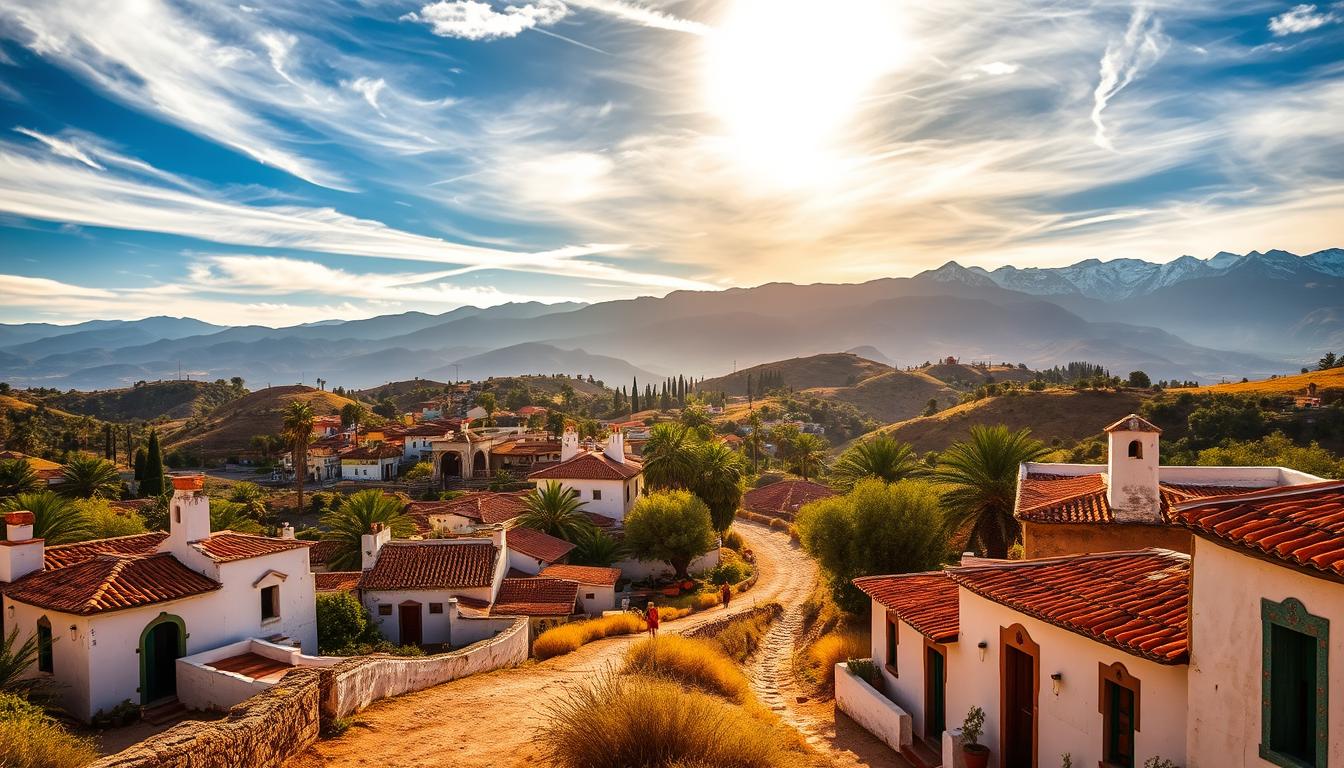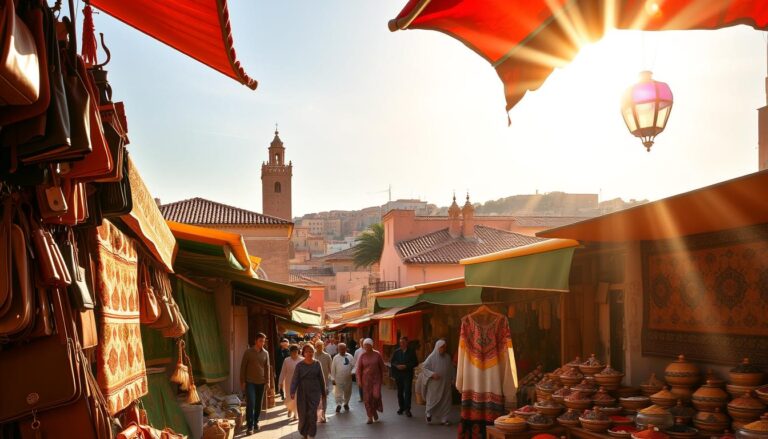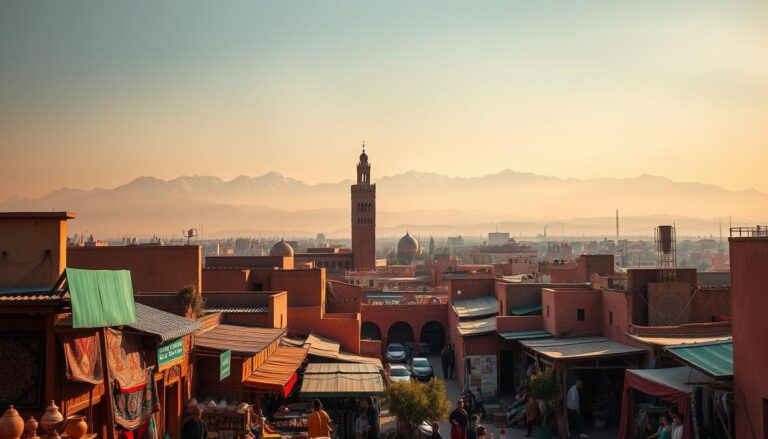10 Hidden Rural Villages in Morocco You Must See
Table of Contents
10 Hidden Rural Villages in Morocco You Must See
Did you know 80% of travelers to Morocco never venture beyond Marrakech or Fez? This leaves entire regions of authentic culture and jaw-dropping landscapes waiting to be explored. Hidden among rugged mountains and desert valleys, small settlements preserve traditions that urban centers lost decades ago.
You’ll find communities where time moves differently. Locals still build homes from red clay and harvest olives using methods unchanged since medieval times. These places aren’t marked on most maps, and getting there often means navigating winding roads through the Atlas Mountains or camel trails in the Sahara.
What makes these destinations special? Imagine watching artisans weave carpets with natural dyes or sharing mint tea with families who’ve farmed the same land for generations. The countryside here isn’t just scenery—it’s a living museum of human resilience and creativity.
Visiting these areas lets you experience Morocco’s heartbeat. You’ll taste bread baked in communal ovens, hear stories passed down through oral traditions, and sleep under stars unobscured by city lights. Every interaction reveals how deeply connected people remain to their land and heritage.
Key Takeaways
- Discover settlements preserving centuries-old Berber traditions
- Experience landscapes ranging from mountain cliffs to desert oases
- Engage with artisans practicing time-honored crafts
- Enjoy hospitality rooted in cultural pride
- Support sustainable tourism protecting local heritage
Discover Morocco’s Hidden Rural Villages
Morocco’s heart beats strongest in its lesser-known communities, where time-honored customs shape daily life. These areas remain untouched by mass tourism, offering raw cultural immersion you won’t find in guidebooks.
Unveiling the Mystique of Rural Life
Walk through valleys where families still harvest crops by hand and share stories under almond trees. You’ll see homes built from earth and stone—structures designed to stay cool in summer and warm in winter. Over 40% of Morocco’s population lives in these areas, maintaining practices perfected over centuries.
Seasonal rhythms dictate life here. Spring brings olive harvests, while autumn means walnut gathering. Community ovens bake bread daily, filling the air with smoky aromas. These patterns create a connection to the land that feels almost magical.
Why These Areas Are a Must-Visit
You’re not just observing history—you’re living it. Watch artisans create pottery without electric wheels, their hands shaping clay as their ancestors did. Share sweet mint tea with shepherds who navigate mountain trails older than written records.
These communities prove sustainability isn’t a trend—it’s survival. Their water systems use ancient irrigation methods, and crops grow without synthetic fertilizers. You’ll leave understanding why preserving these traditions matters to the entire world.
Experience the Authentic Rural Lifestyle
Imagine waking to the scent of freshly baked bread carried on mountain breezes—this is daily life in Morocco’s agricultural heartlands. Farmers here still plow fields with mules and irrigate crops using centuries-old water channels. You’ll join families gathering olives by hand or pressing argan nuts into golden oil, methods unchanged for generations.
Days follow nature’s clock. At dawn, you’ll hear the rhythmic clang of blacksmiths shaping metal tools. By midday, women knead dough in shaded courtyards while sharing news. Evenings bring communal meals under fig trees—platters of couscous topped with vegetables grown steps away.
These areas thrive on collective knowledge. Watch how terraced fields prevent soil erosion on steep slopes. Learn why certain crops rotate with the moon phases. Every action connects to the land’s needs, creating a balance modern agriculture often misses.
You’ll gain skills like weaving drought-resistant grass into baskets or repairing ancient irrigation systems. More than observations, these hands-on moments reveal how communities sustain themselves through shared labor and wisdom. It’s a lifestyle where every person’s role strengthens the whole—from child shepherds to elder storytellers.
Exploring the Natural Landscapes and Agricultural Heritage
Morocco’s landscapes unfold like pages from an ancient manuscript—each valley and plateau tells stories of human ingenuity. Across these areas, communities work with the land rather than against it, creating sustainable systems modern countries study today.
Breathtaking Landscapes and Scenic Views
You’ll see nature’s extremes here. Terraced fields climb Atlas Mountain slopes like staircases to the sky. Near the Sahara’s edge, palm groves erupt around hidden water sources. These scenes showcase how agriculture adapts to harsh conditions.
Look closer. Almond blossoms dust slopes in spring. In autumn, walnut trees turn golden. Each season paints new patterns across the land. You’ll understand why these areas inspire artists and geographers alike.
Traditional Farming Practices and Land Use
Farmers here use methods perfected over 1,000 years. Khettaras—underground canals—pull water from mountains to fields without pumps. Terraces prevent soil erosion on steep hills. Oasis gardens grow dates, figs, and barley in layered plots.
See how they work with natural resources:
| Practice | Purpose | Regions |
|---|---|---|
| Khettara irrigation | Water conservation | Draa Valley |
| Terraced farming | Soil retention | High Atlas |
| Oasis agriculture | Heat adaptation | Sahara fringe |
| Rotational grazing | Land restoration | Middle Atlas |
These techniques keep population density low but productivity high. Farmers swap seeds adapted to local climates, preserving biodiversity. You’ll taste heirloom wheat varieties found nowhere else on Earth.
Architectural and Historical Treasures in Rural Morocco
What if every building told a story? In Morocco’s lesser-known towns, structures crafted by medieval hands still stand proud against time’s march. These areas hold more than clay walls—they’re physical records of survival, artistry, and cultural fusion.
Medieval Structures and Historic Sites
You’ll find kasbahs with honeycomb-patterned towers that cooled desert winds. Fortified granaries cling to cliffsides, their stone shelves once storing harvests for lean years. Each settlement reveals clever adaptations—like riad courtyards channeling sunlight into shaded living spaces.
Look closely at ancient mosques. Their cedarwood doors bear geometric carvings blending Berber symbols with Arab calligraphy. Underground hammams used gravity-fed water systems centuries before modern plumbing. These designs prove sustainability isn’t new here—it’s ancestral wisdom.
| Structure | Key Feature | Cultural Influence |
|---|---|---|
| Kasbah | Defensive earth walls | Berber/Andalusian |
| Riad | Central garden courtyard | Arab/Persian |
| Agadir | Cliffside grain storage | Amazigh tribes |
| Zaouia | Doméd religious school | Islamic/Sufi |
Master masons still repair these sites using palm-rib scaffolding and clay plaster. You’ll see how earthquake-resistant designs use flexible foundations—knowledge passed through generations. These towns aren’t frozen in time. Families convert historic homes into guesthouses, blending heritage with modern comforts.
In one valley, you might find a 12th-century synagogue beside a Sufi shrine. Another area reveals Roman-era irrigation channels feeding olive groves. This layered history shows why preserving these places matters—they’re living classrooms where cultures converge.
Savoring Local Cuisine and Cultural Traditions
Your journey through Morocco’s heartland isn’t complete until you taste flavors shaped by sun-baked earth and generations of wisdom. In these areas, meals become celebrations of what the land provides—no supermarkets, no shortcuts.
Culinary Delights of the Countryside
Every bite tells a story here. Women grind spices in stone mortars while men tend clay tagine pots simmering over olive-wood fires. You’ll taste:
- Harcha bread—cornmeal rounds cooked on hot stones
- Slow-cooked lamb with wild thyme and preserved lemons
- Amalou—almond butter drizzled over fresh figs
| Season | Signature Dish | Key Ingredient |
|---|---|---|
| Spring | Bessara soup | Fava beans |
| Summer | M’smen flatbread | Local wheat |
| Autumn | Date-stuffed couscous | Palm oasis dates |
| Winter | Harira stew | Lentils & chickpeas |
Cultural Encounters and Local Festivities
“Food is how we keep our ancestors at the table,” says Fatima, a cook in the Tafilalt region. Join olive harvest dances where workers sing as they pick fruit. At Imilchil’s engagement festival, share sfouf cakes symbolizing unity.
You’ll learn why mint tea pours from heights—aerating the sweetness. Even simple acts like shaping bread dough become lessons in patience. These traditions aren’t performances—they’re living threads connecting past and present.
Travel Tips for Rural Explorers
Exploring Morocco’s lesser-known regions requires smart preparation. You’ll discover stunning areas where roads twist like mountain streams and services operate on nature’s timetable. Smart planning turns challenges into adventures.
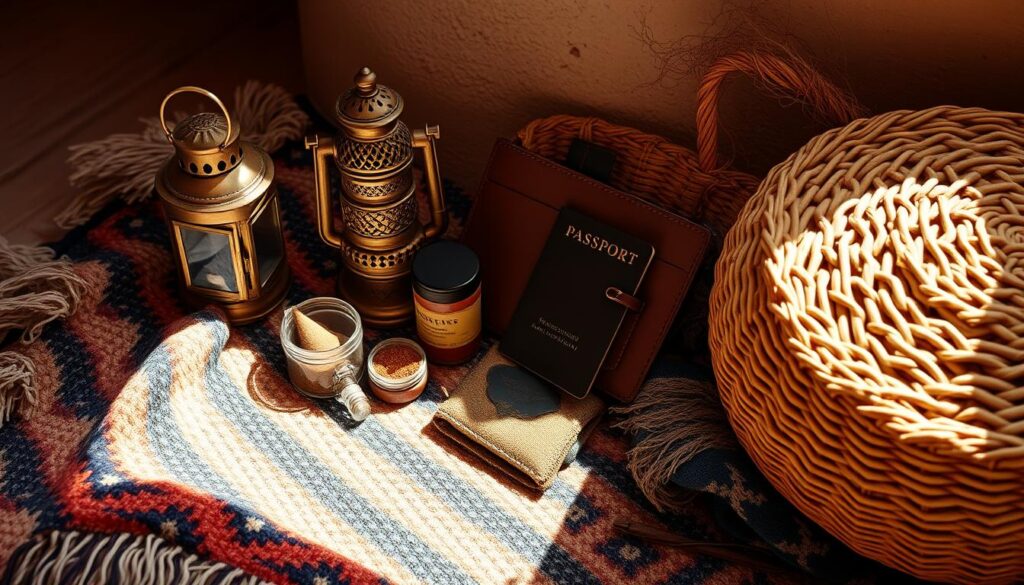
Practical Itinerary Planning
Check weather patterns before booking. Summer heat makes desert areas tough for hiking, while winter snow blocks Atlas Mountain access. Local guides often know alternative routes during seasonal shifts.
Transportation needs vary by location. Some towns require 4WD vehicles—rental companies in Marrakech offer rugged options. For remote settlements, shared taxis or guided mule treks become your best bet.
Must-Know Local Customs and Packing Essentials
Pack light but strategic. Include:
- Reusable water bottles (filtering tablets recommended)
- Layered clothing for desert nights/mountain days
- Basic first-aid supplies
Dress modestly to respect traditions. Loose pants and covered shoulders work best. Learn greetings like “Salam alaykum” (Peace be with you) to connect with locals.
Remember—government resources like hospitals sit hours from many areas. Download offline maps and carry cash. Your preparedness lets you focus on the magic around you.
Understanding the Impact of Sustainable Tourism
Did you know sustainable tourism now supports over 20% of jobs in some Moroccan regions? This approach helps developing countries protect cultural treasures while boosting local economies. Visitors directly fund schools, healthcare, and water systems through their travel choices.
Your stay in these areas creates ripple effects. Families earn income by hosting guests or selling handmade crafts. Farmers supply restaurants with organic produce instead of relying solely on unstable crop prices. Every dirham spent locally strengthens community resilience.
| Impact Type | Example | Benefit |
|---|---|---|
| Direct Income | Family-run guesthouses | Year-round revenue |
| Local Sourcing | Restaurant food purchases | Supports 15+ farms |
| Infrastructure | Tourism-funded wells | Clean water access |
| Cultural Preservation | Craft workshops | Saves ancient skills |
Communities reinvest tourism dollars wisely. One cooperative used earnings to build a women’s weaving center. Another restored a 400-year-old irrigation system. These projects improve quality of life while keeping traditions alive.
Choose experiences that give back. Look for guides from the area and lodges employing local staff. Your decisions help maintain the balance between progress and preservation in Morocco’s most authentic regions.
Navigating Rural Infrastructure and Modern Amenities
Traveling through Morocco’s hidden regions reveals a delicate balance between tradition and necessity. While cities hum with Wi-Fi and ATMs, these areas operate on different terms—where solar panels power clay homes and shared wells quench thirst.
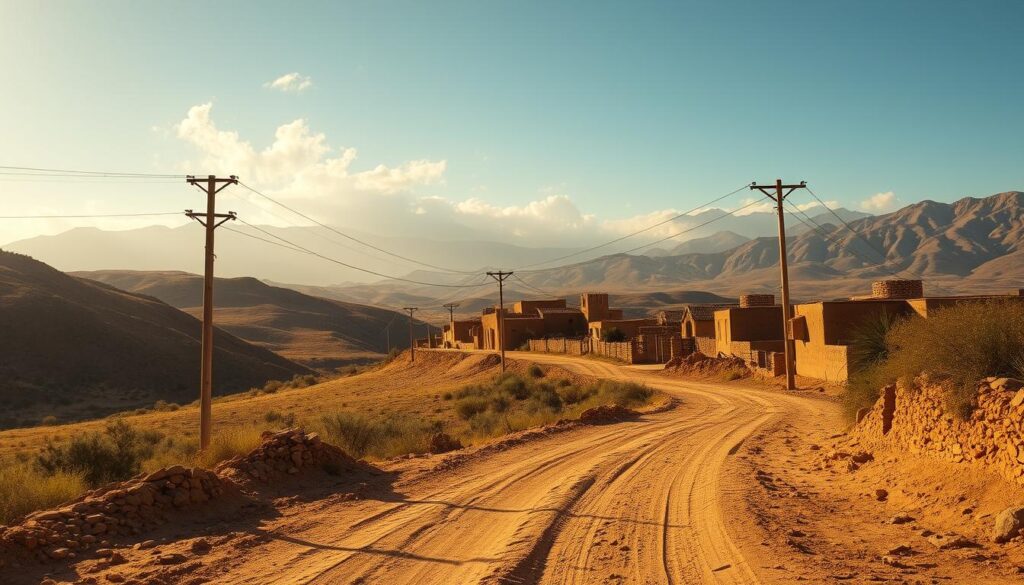
Access to Essential Services and Connectivity
You’ll notice electricity arrives in waves here—some areas have consistent power, others rely on generators. Internet signals play hide-and-seek in mountain valleys. Healthcare? Basic clinics serve scattered populations across vast terrain. Lower population density makes comprehensive services challenging but sparks creative workarounds.
Essential amenities cluster in larger towns. Need cash? Plan ahead—ATMs might be a day’s hike away. Postal services and phone shops become community hubs. Locals often travel weekly for supplies, blending errands with social visits.
Connectivity tests your adaptability. Cell service fades on winding Atlas roads. Rain transforms dirt paths into temporary rivers. Buses run when seats fill—not by timetables. These rhythms teach patience and reward flexible travelers.
Communities thrive through shared solutions. Solar arrays power entire settlements. Ancient water channels feed modern drip irrigation systems. Families pool resources for grinding mills or medical transport. You’ll witness resilience shaped by necessity.
Embracing these conditions deepens your experience. Limited amenities strip away distractions, letting authentic connections flourish. You’ll gain new respect for systems sustaining life where modern conveniences take a backseat to ingenuity.
Conclusion
Your journey through Morocco’s hidden gems reveals more than stunning landscapes—it uncovers living traditions. These communities show how cultural resilience thrives where modern life hasn’t erased ancestral wisdom. You’ve seen firsthand how time-tested practices sustain both people and land in harmony.
Across these areas, daily life proves population density doesn’t dictate prosperity. Families maintain irrigation systems older than some countries’ governments. Artisans craft goods using methods unchanged for centuries. This isn’t nostalgia—it’s a masterclass in sustainable living.
The world gains when these places flourish. Their survival protects biodiversity, safeguards craft traditions, and offers climate solutions. By visiting responsibly, you help preserve knowledge urbanized societies desperately need.
Let your memories linger on shared bread from clay ovens and starry nights untouched by light pollution. These experiences don’t just change your perspective—they support communities writing tomorrow’s survival guide with yesterday’s wisdom.

